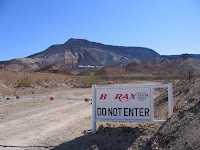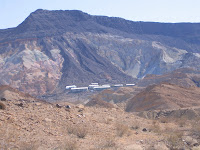We spend a lot of our time in U.S. National Parks. In fact, just this morning I did a 5+ mile run in one a few minutes from my house. Our vacations tend to center around trips to national parks. I've lost count of the number of times I've been to the bottom of the Grand Canyon--
The junction of South Kaibab, N. Kaibab and Bright Angel trails.
I've been on all, many times.
However, most of the big famous parks are literally in the middle of nowhere. How do you get there? It turns out that the existence of, and access to, at least some of the national parks is intimately linked to the interests of American railroad companies in the late 19th and early 20th centuries.
Our first and most famous park is Yellowstone, which is a huge caldera, a giant volcanic plume that has burned a path across the surface of North America. While we're waiting for the next eruption, we wander the surface of the caldera looking at evidence of something strange under our feet; the geysers and thermal features.
Castle Geyser in the Yellowstone Geyser Basin
Yellowstone National Park was created in 1872, but it was darned hard to reach. Only 300 people made it out that year. Several years later, Northern Pacific Railroad built facilities to provide access to the north entrance. Then you rode a horse or a stagecoach ($40 for a 5 day adventure) to get into the park itself. Visitation jumped to 5,000 by 1883. Union Pacific hooked to the west entrance in 1908. All this has been replaced with roads for cars and trucks. In 2009 over 3 million people visited Yellowstone.
The railroads realized national park tourism was a great way to get people to travel on their railroads. After the fabled Atchison, Topeka, and Santa Fe Railroad built a line through Williams, Arizona, then a spur to the Grand Canyon itself, they became active developers of facilities on the South Rim and an ally of federal agencies who managed what developed into Grand Canyon National Park. The El Tovar was built in 1905 on the Rim with Santa Fe's partner, the Fred Harvey Company to house tourists. Here's a view of El Tovar perched on the Rim (Click to enlarge)--
Union Pacific Railroad watched Santa Fe's success and decided to build a set of lodges to be connected to their spur line in Cedar City, Utah by touring cars on roads from the railhead. Like the Santa Fe, they allied with the Park Service to build facilities at the Cedar Breaks, Zion, and Bryce in Utah, and at the North Rim of the Grand Canyon. The Grand Canyon Lodge opened in 1927. Although it burned in 1932, it was rebuilt. Here's what it looks like today--
I've stayed here several times, beginning in about 1980. Union Pacific hoped that well-off tourists would pay to visit scenes like this view from the North Rim of the Grand Canyon and the hoodoos of Bryce Canyon.
At what's now Death Valley National Park, there were no transcontinental railroads to bring tourists to lowest, hottest spot in the country. However, the Pacific Coast Borax Company (PCBC) and its precursors had been profitably mining borax deposits in the area for years. Here's a 20 Mule Team Wagon string and the steam tractor that replaced it--
In 1905, PCBC went into the railroad business. The Tonopah and Tidewater Railroad, was created mostly to bring borax from mines in the mountains east of Death Valley. The main line was standard gauge track from Ludlow, California in the Mojave Desert, north through Death Valley Junction in the Amargosa Valley, on to Tonopah and Goldfield in the Great Basin Desert after combining with other small railroads. From Death Valley Junction, they built a narrow gauge railroad, the Death Valley Railroad, to the borax mines at present-day Ryan.
When other, better borax mineral deposits were developed elsewhere in the 1920s, PCBC decided to start a tourism operation to use the rail facilities. They built a luxury resort, the Furnace Creek Inn, at the edge of Death Valley that they opened in 1927.
PCBC arranged a winter travel package with the Santa Fe and Union Pacific railroads to bring tourists out to Death Valley Junction, then put them on the narrow gauge spur Death Valley Railroad to Ryan. At Ryan the the tourists were loaded on touring cars from Union Pacific that were used to reach Bryce in the summer, and carried the final miles into Death Valley.
To further entice tourists, PCBC very actively lobbied the National Park Service to designate Death Valley as a national preserve. They brought the first director of the NPS, Steven Mather, out to the area. Mather declined to actively lobby, since he had at one time been PCBC's advertising manager (Which makes one wonder why he needed any introduction to the valley.). Mather passed away unexpectedly in 1930, the lobbying effort proceeded, and the area was designated Death Valley National Monument in 1933.
There's more than a bit of irony in this last attempt to use a national park/monument designation to lure travelers to ride the rails. PCBC's timing was horrible because the new era of motor cars and roads was taking over. Travelers liked the Inn, but preferred to use their own vehicles. The Death Valley Railroad ceased operation in 1931. So PCBC missed the train in the end. They brought in The Fred Harvey Company to manage Furnace Creek in 1956, then sold the properties to Fred Harvey, Inc. in 1969. Fred Harvey was acquired by Amfac Corporation in 1968, but must have been run as a wholly owned subsidiary for years after that. I stayed in Fred Harvey lodges and ate at Fred Harvey restaurants well into the 1980s before they started calling themselves Amfac, then renamed themselves to Xanterra in 2002. Amfac started life as American Factors, a Hawaiian sugar company. These days, PCBC is part of U.S. Borax, which is in turn a division of the Australian mining company Rio Tinto. They still own the borax deposits at Ryan in the park, although their active operation is the world's largest open pit borax mine. I realized I've driven within a few miles of the mine several times on my way to or from the Death Ride, which has nothing to do with Death Valley, despite the name.
There's more than a bit of irony in this last attempt to use a national park/monument designation to lure travelers to ride the rails. PCBC's timing was horrible because the new era of motor cars and roads was taking over. Travelers liked the Inn, but preferred to use their own vehicles. The Death Valley Railroad ceased operation in 1931. So PCBC missed the train in the end. They brought in The Fred Harvey Company to manage Furnace Creek in 1956, then sold the properties to Fred Harvey, Inc. in 1969. Fred Harvey was acquired by Amfac Corporation in 1968, but must have been run as a wholly owned subsidiary for years after that. I stayed in Fred Harvey lodges and ate at Fred Harvey restaurants well into the 1980s before they started calling themselves Amfac, then renamed themselves to Xanterra in 2002. Amfac started life as American Factors, a Hawaiian sugar company. These days, PCBC is part of U.S. Borax, which is in turn a division of the Australian mining company Rio Tinto. They still own the borax deposits at Ryan in the park, although their active operation is the world's largest open pit borax mine. I realized I've driven within a few miles of the mine several times on my way to or from the Death Ride, which has nothing to do with Death Valley, despite the name.
These days, the series of luxury resorts built by railroads, mining companies, and other commercial interests are usually owned by the National Park Service. NPS contracts with resort and tourism companies, like Xanterra and Forever Resorts to operate the facilities. I think Furnace Creek Inn and Ranch are actually owned by Xanterra, not the NPS. Millions of ordinary people reach the national parks by private vehicle. As private transportation becomes more expensive, it's likely the more remote national parks may once again become beautiful places in the middle of nowhere, visited by the wealthy and the determined. In many places, like Yellowstone and Death Valley, the rails have been removed. Xanterra has resurrected the Grand Canyon Railway from Williams to the South Rim. The big railroads now only carry freight. What's left of their passenger services have been subsumed into our national rail company, Amtak. For fun I just tried to find an Amtrak ticket for a trip from my home in Tucson to Williams Arizona. Both places have stations, but the system couldn't provide a route. If you're my age, your grandparents would have ridden the rails to reach the National Parks. Perhaps you or your children will only have that option in the years to come, assuming we rebuild the rail systems.
P.S. You're probably wondering, what the heck is borax? Look here.
P.S. You're probably wondering, what the heck is borax? Look here.











No comments:
Post a Comment
Note: Only a member of this blog may post a comment.